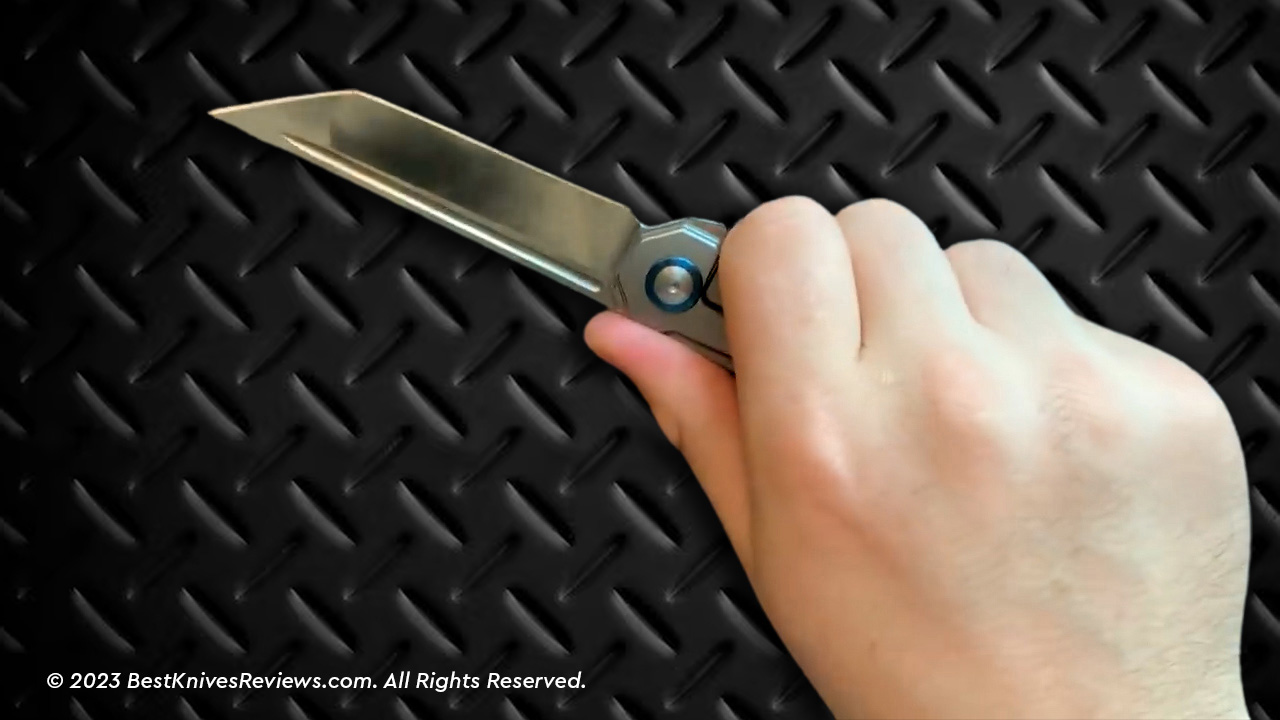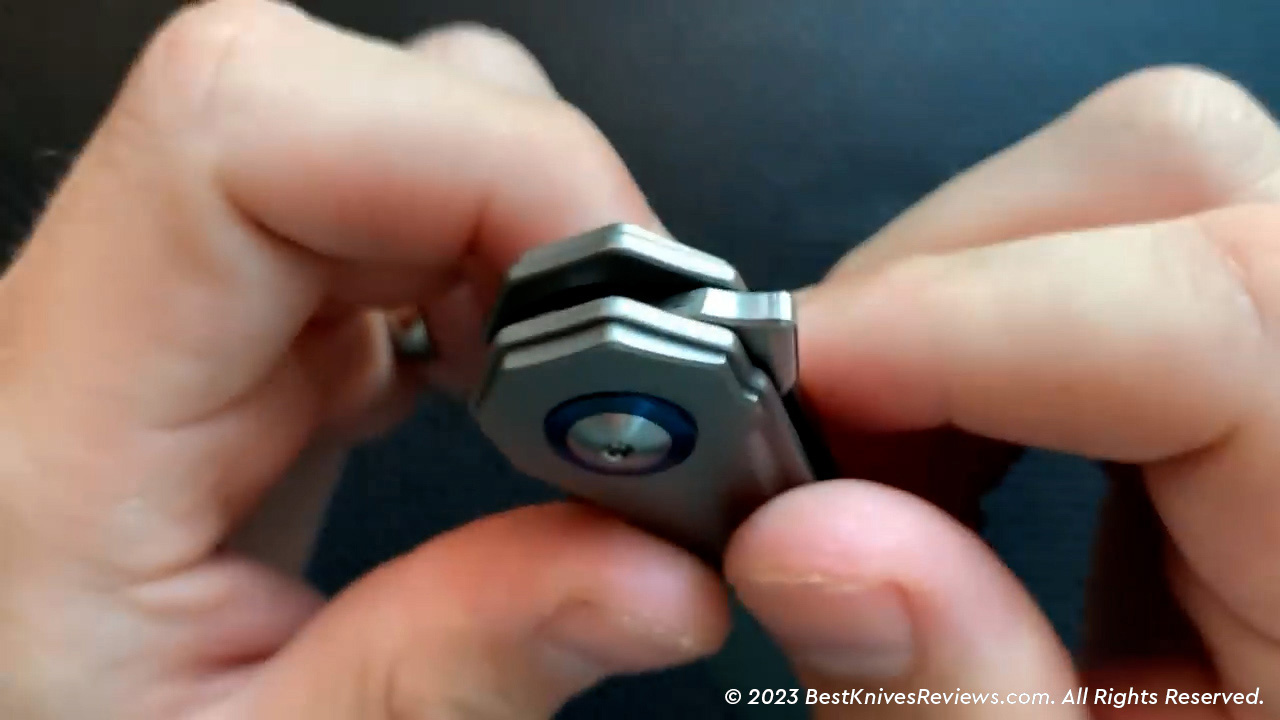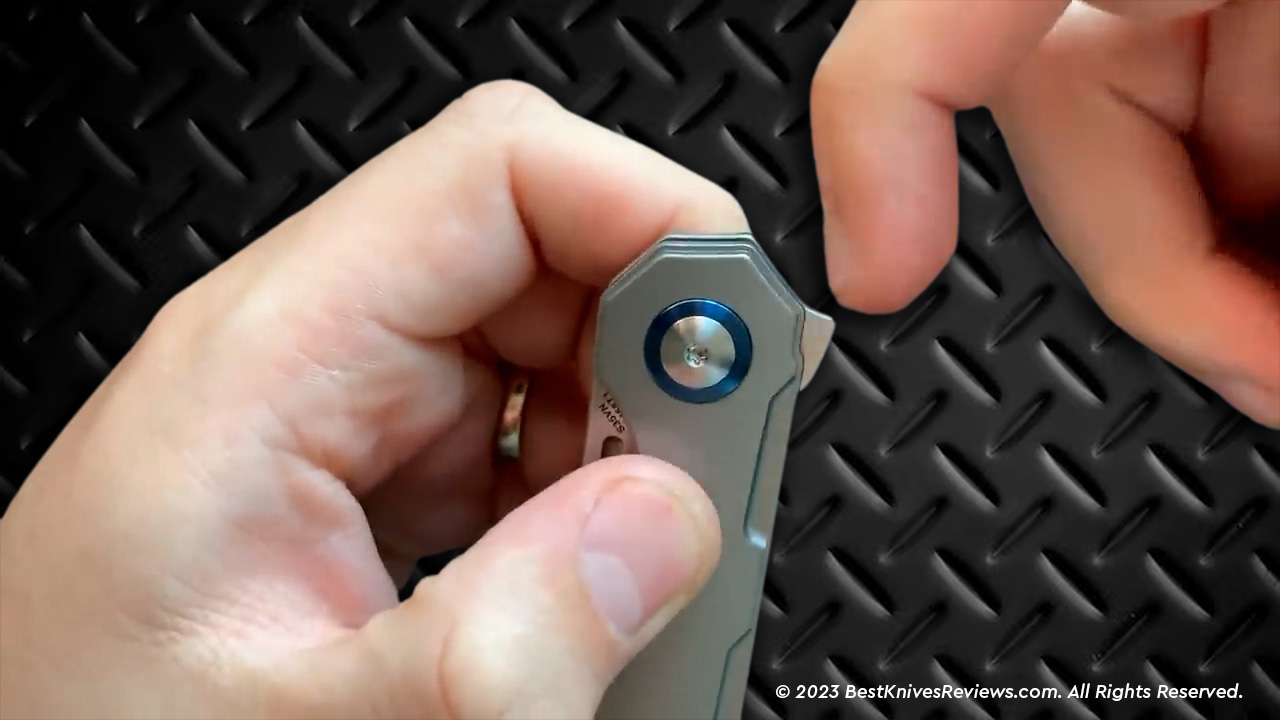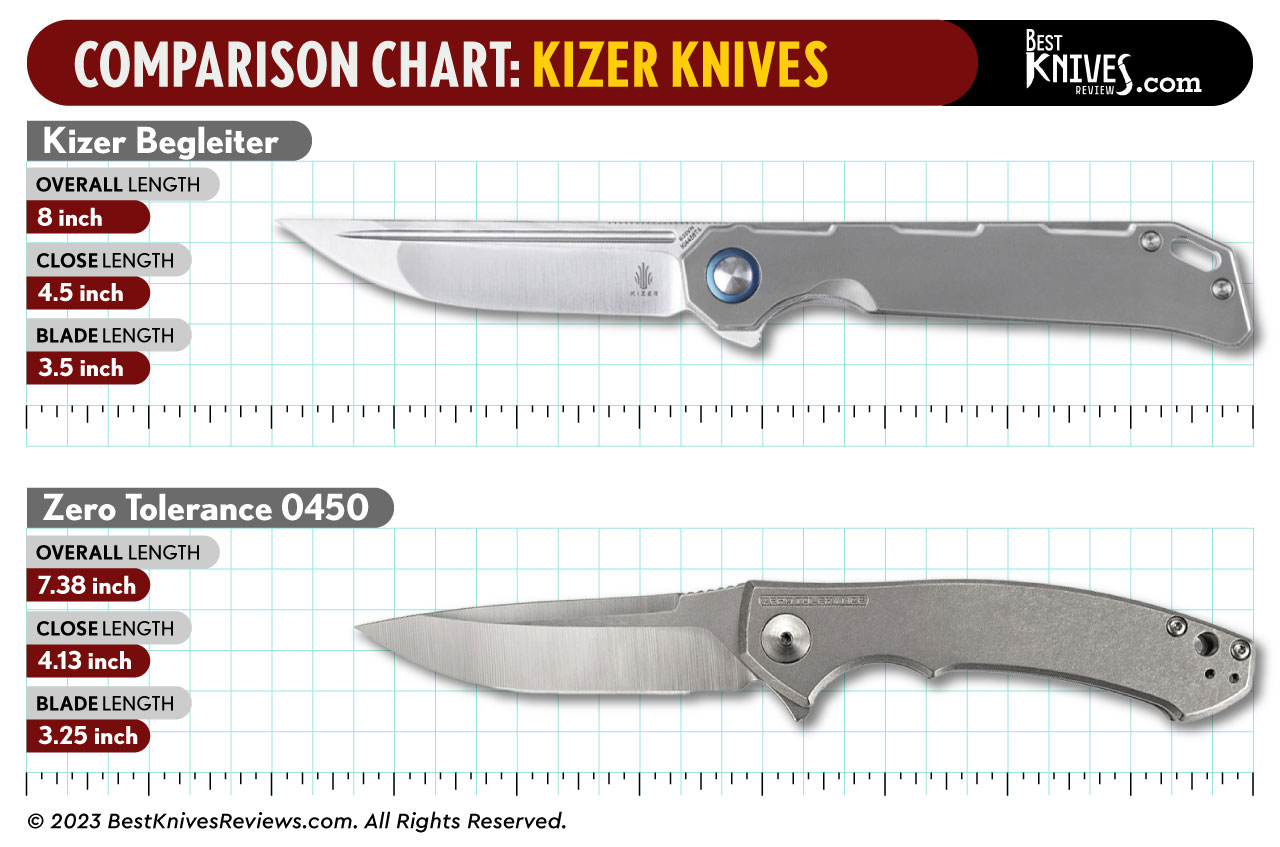Kizer Begleiter is another folding knife by Kizer, a Chinese knife manufacturer that makes high-end yet affordable pocketknives. This version of the Kizer Begleiter is the upgraded Prime variant of the original Begleiter folder that was a part of Kizer’s Vanguard value knives series. It consisted of G-10 scales with a thumb stud and stainless steel liner lock.
This version of the Kizer Begleiter (German for ‘companion’) has titanium scales with a frame lock and flipper. The original Begleiter costed around $60, but this one uses premium materials and costs 2.5x more than the original. But let’s see if it offers any added benefits.
Kizer Begleiter Review
The Kizer Begleiter is about 8.17″ long with a blade length of 3.5” and handle length of 4.625”. The knife profile is pretty straight and thin with a narrow width. The Tanto blade edge shape makes it very unique. There are hardly any awkward edges protruding out of the knife. It also comes with a lanyard hole with extended tang and a small pocket clip. The handle is gray titanium and the blade is CPM S35V with a satin finish.


Key Specifications of Kizer Begleiter
First Impressions of Kizer Begleiter
The Kizer Begleiter came in a very premium packaging. It came in the same black box that almost all Kizer products come in. The cardboard box was of premium quality, followed by another package complete with the instruction manual with details and knife specifications, a velvet pouch and a piece of cloth for maintenance. Then, carefully bubble-wrapped inside was the product itself.

The knife looked impeccable right out of the box – shiny and without any scratches. The blade was also quite sharp right out of the box. The handle felt smooth yet grippy. The slender profile of the knife was quite noticeable. But the blade and handle’s thinness was well-aligned, so no complaints there. The hollow grind lines also look spectacular, ready to get to use.

Therefore, we dove right into it and cut a piece of paper. And as expected, the job was well-done. It sliced through the paper seamlessly and effortlessly. The action felt quite smooth.

We also tested the screws on the knife and discovered that they were T6 at the bottom and T8 at the pivot – the blue anodized one. So the ones around the pocket clips are Torx T6, and relatively easy to unscrew and disassemble for maintenance.

The flipper tab and lockup also worked really well. The blade is easy to disengage either way. It unlocks with a single wrist flick and flips back into position the other way round. The detent is very appropriate for this knife. It does not require much effort, and it does not disengage on its own.

But it also drops and locks itself even if the lock fails. But you may need to be careful when pressing your thumb into the lock. If you haven’t used a frame lock before, it may seem odd, but the lockup itself it excellently deployed.

The pocket clip is not deep, but it slides easily into the pocket and can be discreet enough. It is only configured for right-hand tip-up carry, but has a nice finish to it just like the rest of the knife does. The satin blade finish is not bad as it may seem compared to stonewash. The bead-blasted finish on the scales is also very well-done. So we can say that the knife left positive impression on us.
The Blade of Kizer Begleiter
A blade as thin and straight as on the Begleiter is rare in our experience. And the blade’s arched transition from the primary bevel to the tanto’s bevel is visually striking at first effect.
You can see a fuller groove running along the length of the blade parallel to the spine. The pointed edge of bade angles high enough to make an acute needle tip.

The factory sharpness of the blade was also quite impressive. It came sharp right out of the box. Same was the case with Kizer Yorkie. It also has very clean and even hollow grinds visible on the blade side.
The blade’s stock thickness of 0.12” aligns itself with the overall blade profile. Although it does turn thinner towards the edge to make it sharp. The stock thickness is pretty reasonable on this knife, since the knife itself is quite thin with just 0.50”.

The spine edges are rounded and soft to touch and has a small sharpening choil. The blade has excellent edge geometry to avoid any edges poking out near the choil. The plunge grind lines also look appealing with an almost vertical line running parallel to the forward guard scale. It extends with hollow radius grinds turning into primary bevel. It shows that the machining on this blade was carefully and well done.
The CPM S35VN is a premium blade material with a careful balance between edge retention, hardness, corrosion and stain resistance and ease of machining and sharpening, as compared to S30V. It may be relatively easy to sharp, but the hollow grind may make it more time consuming.
Handle Ergonomics of Kizer Begleiter
The Kizer Begleiter features titanium scales that are lightweight yet strong and corrosion resistant. The scales on Begleiter are perfectly sculpted and contoured that makes it very smooth. The textured pattern is intricately machined with no swedges and a gentle swell in the middle. The scallop-shaped thumb groove provides easy access to the lock bar release.

The front flipper tab is seamlessly built in the titanium scales that provides a solid place to place your forefinger to open up the knife. You can see the lanyard hole at the base of the handle in an oval-shaped slot between two standoffs. The two hourglass-shaped standoffs shapes the knife into an open-backed construction. It is screwed with Torx screws from the male and female pivot ends barreled to the frame. It is not as well done as one would hope, considering that it requires a third hand to unscrew and disassemble the knife properly. However, the blue anodized pivot collar is a nice touch.
The skeletonized liners are a bit aggressive if we disassemble the knife, but it also helps keep the knife weight down. There is also a couple of steel washer inserts that sit between the bearing cartridges and inner handles. They prevent the hardened bearings from tearing up the inner softer titanium scales

The pocket clip is 3D machined milled titanium configured for right tip-up carry. It is screwed together by two screws threading their way into the rearmost standoff. The carved leading edge between the two makes it easier to slide into the pocket. The bridge of the clip is quite thin but has a nice tension strength and flexibility. The milling on the interior pockets is also nice without any blaring edges or rough spots.
The handle has a bead-blasted finish that compliments the contrast satin blade finish well. Both the finishing are evenly applied.
The ergonomics of this knife also seem good. Even though the handle is sleek titanium, it provides a good grip and traction. It is maneuvered in just the right spots and fits all the knuckles for a comfortable yet grippy hold while performing cutting tasks.
Deployment & Lockup of Kizer Begleiter
You can deploy the Kizer Begleiter with a flipper and lock it via frame lock. The flipper tab on Begleiter is fantastic: the tab is short, well-placed and well-shaped. The tab transitions to the concave contact surface on leading edge that does not get in the way of your finger or forefinger. There is also no sandpaper landing zone on the spine where your finger lands.
The detent however, gets in the way when you have to be conscious of your middle finger not getting in the way of pressing into the lock bar. It makes the knife challenging to open, especially because of the narrow handle shape.

But the detent is not too stiff and the ball-bearings are very smooth. Because of this, the Begleiter flips seamlessly. You can disengage and erect the blade with a single flick of your wrist and the blade will shut down. It requires a very light pressure on the detent with smooth pivot cartridges.
The frame lock works just as well as the flipper. It even works fine after months of use, showing its reliability. It uses a stainless lock bar inserted into the titanium scales with two screws that bring the lock face and steel blade together.

It prevents galling of the softer titanium inside when it contacts the blade. There is also a stop pin inside the lock bar to prevent pushing the lock bar past its open position and losing its tension. The stop pin rides on two channels inside the scales to monitor the blade’s open and closed positions. That means batoning is not recommended.

The Flipper tab is little small and at times, if you do not push very hard instantly, you won’t get full deployment action. The frame lock however, does not come with a lock stick. At the same time, you will not experience vertical or horizontal blade play. It is safe to say that the frame lock is excellently deployed. It automatically covers any potential drawbacks.
Taking Kizer Begleiter in the Field
Although Kizer Begleiter is coming off great in our review so far. The only issue we faced with the knife in the field was that it was unable to cut the seal off of a bottle of oil, sauces or jars. It was also not able to rip through bubble wrap. The tanto tip failed in this regard. The reason for this is that the blade is pretty straight from top to bottom. There are no swedges. It may look good at first, but its drawbacks reveal in the field.
It is also not a good box cutter, and makes your wrist angle in an unnatural position. A slight turn in the blade’s edge would have got the job done.
I is this one thing that makes the knife undesirable and annoying because thick tanto pointers are supposed to punch through with ease. A lack of finger guard combined with the knife’s exceptionally slim profile makes it hard to pierce through things.

Another thing we noticed when handling the knife was its ergonomics. Although the titanium did not cause as much trouble as the curves of the handle did. It barely had enough room to hold with all the knuckles of one hand. The finger choil was also too small for comfort.
The blade also hides perfectly inside the scales, which again makes the knife lightweight and exceptionally thin. The pocket clip may look attractive, but the functionality of milled titanium clip lacks. It may not be very practical when in rough EDC use. A spring steel clip would work better in its place. The pocket clip also has a tendency to move around even if it is perfectly screwed down. It also lacks the ability to locate the pocket when sliding it in. It may look out and get skewed in a different direction. This also puts added tension in the detent.
Therefore, we can say that this knife prioritizes looks and features over functionality. Although it is not a bad knife – you can still use it to cut paper, cardboard and prepare food. But it is not equipped to handle tougher EDC tasks.
Pros & Cons of Kizer Begleiter
PRO’s
Con’s
Comparisons
Kizer Begleiter vs Kizer Gemini
Kizer Beglieter and Gemini have a lot of things in common. They both have the same blade and handle material, frame lock and flipper deployment. They also fall under the same price range.

However, Begleiter is a bit larger than Gemini and has a drop point blade shape. Its handle is also more functional than the Beglieter’s. It would overcome all the minor shortcomings of Begleiter like having a good edge retention and better ergonomics with a larger finger choil. The full-flat ground stonewashed blade is easier to sharpen than the hollow grind and has an excellent ball-bearing pivot with contoured titanium handle. Although it is a bit heavier than Begleiter, but capable of working under tough EDC tasks.
Kizer Begleiter vs Zero Tolerance 0450
Zero Tolerance is a direct competitor of Kizer and 0450 compares closely with Begleiter. It also has ball-bearing pivot with a stainless lock bar interface. It has the same S35VN blade but has a drop point edge.

Unlike Begleiter, the pocket clip of 0450 is ambidextrous but weighs the same as Begleiter. It is only 0.8” shorter overall than Begleiter but is a high-end equivalent of it. It was also awarded the ‘Overall Knife of the Year’ at Blade Show in 2013. Its ergonomics and edge retention is great, although it is also super slim and sleek like the Begleiter. The flat ground is easier to sharpen, and its ergonomics are great.
Therefore, ZT 0450 does give a tough competition to Kizer Begleiter.
Conclusion – Kizer Begleiter Review
I found Kizer Begleiter reviews online by different websites to be a bit overrated when it came to design, aesthetics and functionally as they it did not exactly balance out. No doubt, the knife is excellently manufactured and designed.
It is attractive and uses high-end blade and handle materials. The frame lock and flipper deployment is not as smooth as it should be but one thing is for sure that it’s a folder with no blade play.
However, we found that it could not perform all EDC tasks in the field. It cut through paper seamlessly and its blade was sharp right out of the box. But when we used it to open bottle seals and punch through bubble wrap, it failed.

It also faced tough competition against Kizer Gemini and Zero Tolerance 0450. Both the knives cost as much as the Begleiter, but won when it came to ergonomics, ease of sharpening, edge retention, pocket clip and overall functionality.
Therefore, it is a good knife and is capable of performing light EDC tasks and food prep, but cannot defy tougher tasks. Users could easily switch to its competitors when it comes to long-term rough usage.
This is why I am rating it 4/5, as good knives always get rating above 4.5 here!
